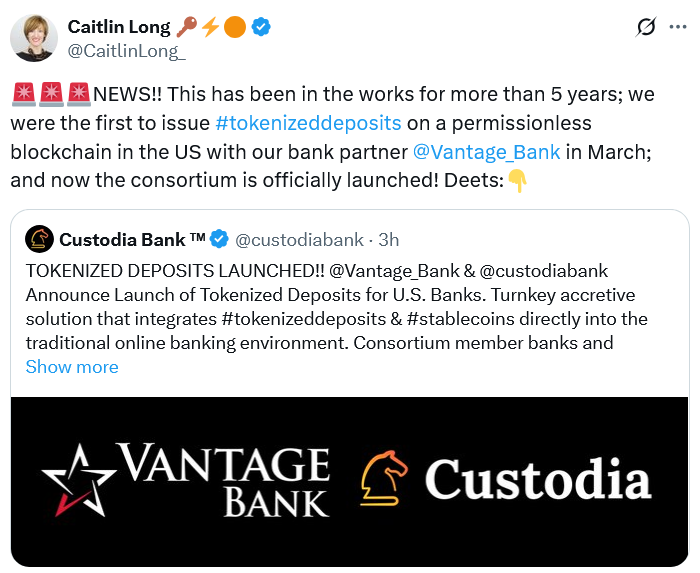Custodia Bank and Vantage Bank have launched a blockchain-based solution for tokenized deposits, allowing traditional banks to issue digital versions of customer deposits that integrate with stablecoins. This innovation enables faster, low-cost transactions while keeping deposits secure and under bank control.
-
Tokenized deposits represent real US dollars on blockchain, bridging traditional banking with crypto efficiencies.
-
The solution supports interoperability, letting banks retain customer funds amid rising stablecoin adoption.
-
Early pilots demonstrate real-world applications, including cross-border payments and supply chain settlements, with the stablecoin market projected to hit $2 trillion by 2028.
Discover how Custodia Bank’s tokenized deposits solution revolutionizes banking with blockchain. Secure deposits, instant transactions, and stablecoin integration—explore the future of finance today.
What Are Tokenized Deposits and How Do They Work with Stablecoins?
Tokenized deposits are digital representations of traditional bank deposits issued on a blockchain, backed by actual US dollars held by the issuing bank. This solution, developed by Custodia Bank and Vantage Bank, allows banks to create these tokens for seamless integration with stablecoins, enabling near-instant, low-cost transactions. By combining tokenized deposits with GENIUS Act-compliant stablecoins, banks maintain full control over customer funds, preventing disintermediation risks.
How Does Custodia Bank’s Solution Enhance Banking Interoperability?
The turnkey blockchain solution from Custodia Bank and Vantage Bank addresses key challenges in financial interoperability by providing a patent-protected framework for tokenization. Institutions can leverage the Infinant’s Interlace network, a bank-focused blockchain and payment platform, to issue tokenized deposits that function alongside stablecoins. This setup ensures secure, efficient transactions without compromising deposit safety.
Supporting data from the US Treasury highlights the urgency: the stablecoin market, currently valued at around $300 billion, could expand to $2 trillion by 2028, potentially causing $6.6 trillion in deposit outflows from traditional banks. Custodia’s approach mitigates this by allowing banks to participate directly in the digital asset ecosystem.
Expert Caitlin Long, founder of Custodia Bank, emphasized in a recent statement: “This framework provides institutions and their customers with the efficiencies and security of tokenization while safeguarding core deposits from the risk of disintermediation.” Early implementations, such as those with Vantage Bank seven months ago—the first in the US on a permissionless blockchain—demonstrate proven viability for banks of all sizes, who retain wallet control over their tokenized assets.
Frequently Asked Questions
What Is the GENIUS Act and Its Impact on Tokenized Deposits?
The GENIUS Act, signed by US President Donald Trump in July 2025, establishes regulatory clarity for stablecoins, boosting their adoption in the financial sector. For tokenized deposits, it ensures compliance when integrating with stablecoins, allowing banks like Custodia to offer competitive digital solutions without regulatory hurdles. This has accelerated institutional interest, with stablecoin volumes surging post-enactment.
Are Tokenized Deposits Safe for Traditional Banks and Customers?
Yes, tokenized deposits are designed with robust security measures, representing real US dollars held in reserve by the issuing bank on blockchain. Custodia Bank’s solution uses permissioned networks to prevent unauthorized access, maintaining FDIC-like protections for core deposits. Customers benefit from blockchain’s transparency and speed, while banks avoid yield competition from private stablecoin issuers, as noted in regulatory discussions.
Key Takeaways
- Blockchain Integration for Banks: Custodia and Vantage’s platform enables traditional institutions to tokenize deposits, combining crypto’s speed with banking stability for interoperable operations.
- Market Growth Projections: With stablecoins at $300 billion and potentially reaching $2 trillion by 2028, tokenized deposits help banks counter deposit outflows estimated at $6.6 trillion.
- Real-World Applications: Pilot programs already support cross-border payments, construction disbursements, supply chain settlements, and flexible payroll, showcasing immediate practical value.

Source: Caitlin Long
Conclusion
In summary, Custodia Bank’s tokenized deposits solution marks a pivotal advancement in bridging traditional banking with blockchain technology, offering secure integration with stablecoins under the GENIUS Act framework. By empowering banks to retain control and capitalize on digital efficiencies, this innovation addresses regulatory concerns over stablecoin competition and deposit outflows. As the crypto market evolves, financial institutions adopting such tokenized deposits will be well-positioned to thrive in a $2 trillion stablecoin landscape—stay informed on these developments to navigate the future of finance effectively.
Custodia Bank has launched a solution that lets banks tokenize deposits, enabling them to benefit from blockchain’s advantages while safeguarding customer deposits. Crypto-friendly banks Custodia Bank and Vantage Bank have introduced a comprehensive turnkey blockchain solution, empowering traditional banks to issue tokenized deposits compatible with stablecoins. This development facilitates the use of blockchain’s near-instantaneous and cost-effective transactions in an interoperable environment across institutions, all while ensuring banks retain full custody of customer deposits, as outlined in their official statement.
The patent-protected framework is meticulously designed to deliver the operational efficiencies and enhanced security of tokenization to institutions and their clients, simultaneously protecting core deposits against the threats of disintermediation. Tokenized deposits serve as blockchain-issued digital equivalents of conventional bank deposits, each backed by genuine US dollars securely held by the banks themselves.
This initiative is strategically aimed at fostering greater interoperability between the cryptocurrency ecosystem and established banking systems through the creation of a unified digital token capable of operating dually as both a tokenized deposit and a stablecoin. The platform remains accessible to financial institutions regardless of scale, with banks exercising complete authority over their wallets that house the tokenized deposits and stablecoins compliant with the GENIUS Act.
At its core, the solution harnesses Custodia’s specialized blockchain and payment platform, Infinant’s Interlace network, tailored specifically for banking needs. This launch follows seven months after Custodia and Vantage achieved a milestone as the inaugural US bank to issue tokenized deposits on a permissionless blockchain.
In the ongoing crypto bull market, driven largely by institutional adoption, banks and traditional finance entities are deploying diverse strategies to engage with the digital asset space. A prominent area of focus has been stablecoins, now representing a $300 billion market that gained significant momentum following the GENIUS Act’s signing by President Donald Trump in July 2025.
Despite this growth, banks have voiced apprehensions to regulators regarding the potential of stablecoin issuers and their affiliates to erode the traditional banking model by providing interest and yields on deposits. The US Treasury’s April assessment projected that the stablecoin sector could balloon to $2 trillion by 2028, potentially triggering outflows of $6.6 trillion from banking deposits.
For banks, embracing tokenized deposits presents a strategic avenue to counteract these outflows and sustain their market position as the industry pivots toward digital innovations. Custodia’s solution is already demonstrating tangible effects through initial pilot programs utilizing its dollar tokenization capabilities.
These pilots encompass facilitating cross-border payments for transportation firms and enabling milestone-linked disbursements in the construction sector. Furthermore, the technology supports streamlined supply chain settlements for manufacturers and offers more adaptable payroll mechanisms within service industries, underscoring its versatility and practical utility in diverse operational contexts.
The broader implications of such advancements underscore a transformative shift in financial services, where tokenized deposits not only preserve the integrity of traditional banking but also propel it into the blockchain era. Regulatory bodies, including the US Treasury, have emphasized the need for balanced approaches to stablecoin growth, and solutions like Custodia’s provide a compliant pathway forward.
Industry observers note that this development aligns with increasing calls for innovation from authoritative sources such as the Federal Reserve, which has explored digital dollar concepts in recent reports. By focusing on interoperability and security, Custodia Bank positions itself as a leader in crypto-friendly banking, potentially setting standards for future adoptions across the sector.





